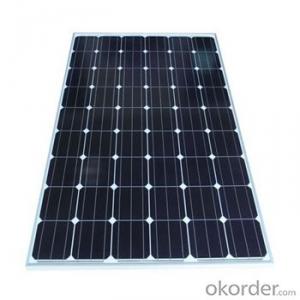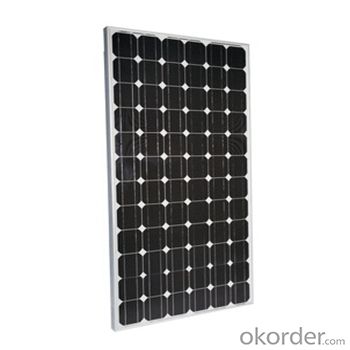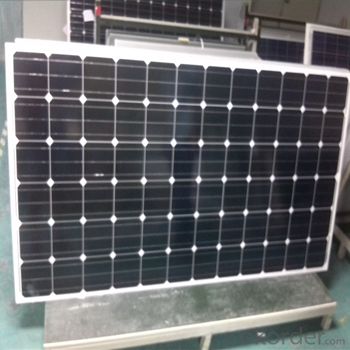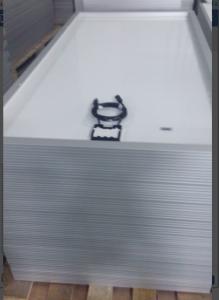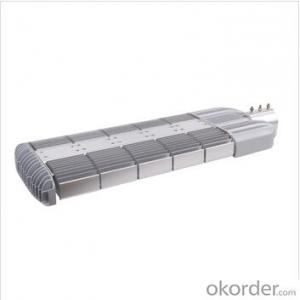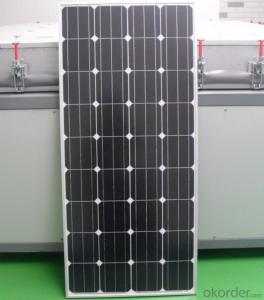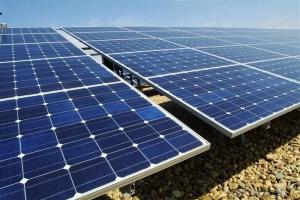Art Solar Panels - Monocystalline Solar Module-250W CNBM Series
- Loading Port:
- Shanghai
- Payment Terms:
- TT OR LC
- Min Order Qty:
- 25 pc
- Supply Capability:
- 20000 pc/month
OKorder Service Pledge
OKorder Financial Service
You Might Also Like
Monocrystalline Solar Module-250w CNBM Series
High efficiency crystalline solar cell. Even if under the weak light, the solar module can produce maximum power output.
II Tempered glass (toughened glass): Anti-reflecting coating and high transmission rate glass increase the power output and mechanical strength of solar module.
III EVA and TPT: Using high quality EVA and TPT to prevent destroying and water.
IV AI frame: Without screw, rner connection. 6 holes on the frame can be installed easily.
V Junction box: Multi function junction box with water proof.
VI Long lifetime: ≥25 years; Less power decrease.
VII Good performance of preventing from atrocious weather such as wind and hails.
VIII Resisting moisture and etching effectively, not effected by geology.
IX The certificate issued by international authority: UL, TUV, IEC, CE.
Standard Test Conditions of Polycrystalline Silicon Solar Panel
The opto-electrical specifications shown below are stabilized values being measured at Standard Test Conditions, Irradiance: 1000W/m2, Spectrum: AM1.5 at 25°C, The info below is subject to manufacturing tolerances. Where appropriate minutes of measurement are available and are used for the dimensioning of the installation.
Advantages of Monocrystalline Silicon Solar Panel
• CNBM Solar performance guarantees for 25 years
• 12 years guarantee for workmanship
• Timeliness of delivery
• Quality Products certified (TÜV, UL, CE, ISO)
Specification

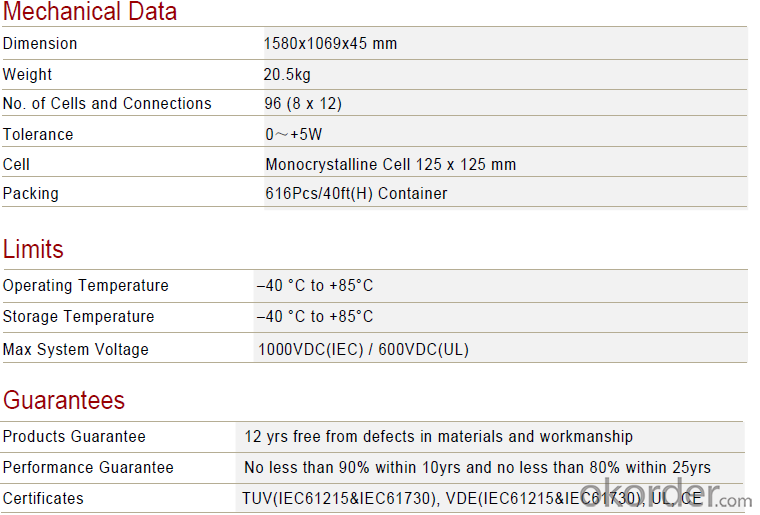
Certification
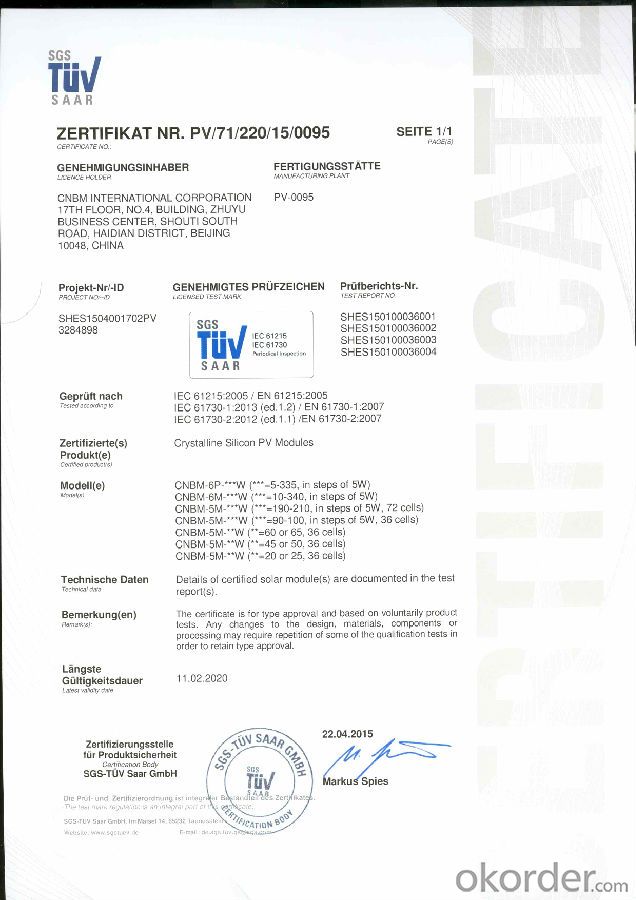
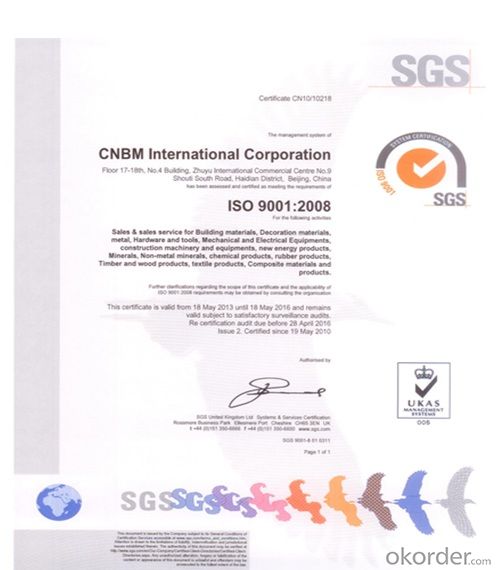

FAQ
We have organized several common questions for our clients,may help you sincerely:
①What price for each watt?
It depends on the quantity, delivery date and payment terms,
②What is your size for each module? Can you tell me the Parameter of your module?
We have different series of panels in different output, both c-Si and a-Si. Please take the specification sheet for your reference.
③Can you provide the peripheral products of the solar panels, such as the battery, controller, and inverter? If so, can you tell me how do they match each other?
Yes, we can, we have two companies for solar region, one is CNBM International, the other is CNBM engineering Co.
We can provide you not only the solar module but also the off grid solar system, we can also provide you service with on grid plant.
④What is your warranty system?
Our product performance guarantees for 25 years
• 12 years guarantee for workmanship
• Timeliness of delivery
• Quality Products certified (TÜV, UL, CE, ISO)
⑤How do you pack your products?
We have rich experience on how to pack the panels to make sure the safety on shipment when it arrives at the destination.
⑥ Can you do OEM for us?
Yes, we can.
⑦How long can we receive the product after purchase?
In the purchase of product within three working days, We will arrange the factory delivery as soon as possible. The pecific time of receiving is related to the state and position of customers.Commonly 7 to 10 working days can be served.
- Q: What is the purpose of solar panels?
- The purpose of solar panels is to harness the energy from the sun and convert it into electricity, providing a renewable and sustainable source of power for various applications.
- Q: we are planing to move out of the grid. we need to operate constantly 2 laptops online - does any one can tell us how much solar panels we shall need to make sure of that?
- Create okorder
- Q: My house is aligned exactly North-South, so I have no roof facing South. Is it worth installing solar panels? Are there any good options for dealing with this situation?
- Depends how much sun you get. Even if you don't face south, you could still be able to harvest a lot of energy from the sun. You could install panels transversely so they face south to increase sun exposure, but this might not look so nice. Or you could move your house to the Southern hemisphere, when your solar panels should face north. Or install miniature windmills on your roof instead.
- Q: Can solar panels be installed on a pergola or shade structure?
- Yes, solar panels can be installed on a pergola or shade structure. In fact, installing solar panels on a pergola or shade structure can provide both shade and renewable energy generation, making it a practical and efficient solution for maximizing space and reducing energy costs.
- Q: I live in Sacramento, CA, and I need some solar panels for a project fo school. They don't have to be very big......just something that I can use as an example.Thanks!
- If they're just to be used as an example, go around your neighborhood, and find a yard with solar yard lights. Then ask the owner whether you might borrow one or two. If they say no, move on and find another house. I'm pretty sure someone will say yes, after you explain what it's for. They will trust you, because you could have just stolen the lights, but instead asked. Option B is to have your parents take you to Fry's Electronics, and purchase a solar item, like a motion detector light, or even a standalone solar panel. As long as you don't mess up the box, you should be able to return it later for credit. But that's borderline dishonest, because you never intended to keep the merchandise.
- Q: Can solar panels be used in areas with high levels of noise pollution?
- Yes, solar panels can be used in areas with high levels of noise pollution. Noise pollution does not affect the functionality or performance of solar panels. However, it is important to note that noise pollution does not directly impact the efficiency or effectiveness of solar energy generation from the panels.
- Q: Dear Friends, I am very much worried about Global warming, So to contribute something for reducing Global Warming I have decided to use Solar Panels. Can anybody tell me what is the price of these Solar Panels and why people are not using them when they are environment friendly. What are the Pros and Cons of these Solar Panels?
- Solar okorder / And thin film solar panel power stations are about 50-60% cheaper now than solar power was in 2000. But they're still not economic in most places. Mike K's claim that solar panels produce more pollution than 'traditional' power is wrong. Coal is over 900g CO2/kWh, plus loads of pollution. Gas is ~400g CO2/kWh.
- Q: Can solar panels be used on vehicles?
- Yes, solar panels can be used on vehicles. Solar panels can be installed on vehicles such as cars, trucks, boats, and even bicycles to generate electricity from sunlight. This electricity can be used to power various components of the vehicle, such as the battery, lights, or even the motor in some cases. Solar panels on vehicles offer a sustainable and renewable energy source, reducing reliance on traditional fossil fuels and contributing to a greener and more eco-friendly transportation system.
- Q: I purchased some small 3.6 v 70mA solar panels online. I have no experience with solar panels. I am confident of the layout of the parallel circuit I want to create, however I don't know how to properly connect the tabs that come from the sides of the panels. Any help on connecting them?
- Okay okorder /... That metal strip up top is negative, if you turn it around and look on the back you will see another metal strip there which would be positive. When it comes to wire, I use 24awg audio wire I got from radio shack, they only have solid wire at this gauge at my local radio shack but stranded is preferable. Solar cells are super fragile too so you're going to want to be extra careful. I then take a length of stripped wire and lay it over the silver tab, I hold it in place with some electrical tape at each end. Here is where experience comes into play, you can't use just any solder when making these connections. Well, you can but it takes a hell of a lot more time and effort to get it right. Make sure to use 96/4 silver-bearing solder. I'm not sure why but 60/40 solder does not adhere very well to the cell and usually the soldering iron has to stay on the cell for far too long which ends up discoloring it. If you need help on how to solder send me a message, you need to know how to properly tin the iron, since this is such a meticulous and unforgiving soldering job.
- Q: How do you know when it is a good deal to buy a solar panel. For example, what is a good cost per watt, how many volts should I expect, etc.
- first okorder / example: house roof is 20' x 20' 20' = 240, so sq. inches of roof is = 57,600 say rain fall for your area is 3 per month on average. 57,600 x 3 = 72,800 of rain collected. Using the conversion chart link above, that many cubic inches of water = 750 gallons of water free per month. Look at your water bill and see how much you use. Solar panels take on average 2-20 yrs to pay themselves off, just in time for them to be replaced. Paddle wheels go on for just about forever. We still find large paddle wheel mills in the USA that are over 200 yrs old, and still functioning.
Send your message to us
Art Solar Panels - Monocystalline Solar Module-250W CNBM Series
- Loading Port:
- Shanghai
- Payment Terms:
- TT OR LC
- Min Order Qty:
- 25 pc
- Supply Capability:
- 20000 pc/month
OKorder Service Pledge
OKorder Financial Service
Similar products
Hot products
Hot Searches
Related keywords
